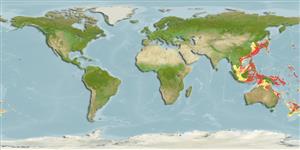Common names from other countries
Environment: milieu / climate zone / depth range / distribution range
Ökologie
seewasser demersal. Tropical
Indo-Pacific.
Size / Gewicht / Alter
Maturity: Lm ? range ? - ? cm
Max length : 61.5 cm TL Männchen/unbestimmt; (Ref. 84366)
Wirbelzahl: 134 - 139. This moderately elongate species of Ophichthus, subgenus Coecilophis is distinguished by the following characters: tail 53-58%, head 11-13% of total length and depth at gill opening 4.0-4.8% of TL; origin of dorsal-fin slightly behind pectoral-tips; pectoral fins spatulate, non-elongate and slightly less than length; large eyes, posterior margin of orbit ahead of rictus; posterior nostril a hole in upper lip and covered by a flap; small, inconspicuous head pores, SO 1+3, IO 4+2, POM 2-3+6-7 (usually 3+7); small, conical teeth, uniserial on mandible and vomer, few anterior teeth on maxillary; color tan on flanks and dorsum, pale ventrally, all fins and anterior nostrils pale, chin and snout dusky; mean vertebral formula 16.2/54.0/136.5, total vertebrae 134-139 (Ref. 84366).
Taken from great depths, rarely from shallow muddy bottoms. Feeds on benthic animals (Ref. 637).
Life cycle and mating behavior
Maturities | Fortpflanzung | Spawnings | Egg(s) | Fecundities | Larven
Masuda, H., K. Amaoka, C. Araga, T. Uyeno and T. Yoshino, 1984. The fishes of the Japanese Archipelago. Vol. 1. Tokai University Press, Tokyo, Japan. 437 p. (text). (Ref. 559)
IUCN Rote Liste Status (Ref. 130435)
CITES (Ref. 128078)
Not Evaluated
Bedrohung für Menschen
Harmless
Nutzung durch Menschen
Fischereien: nicht kommerziell
Tools
Zusatzinformationen
Download XML
Internet Quellen
Estimates based on models
Preferred temperature (Ref.
115969): 4.7 - 19.9, mean 13.2 (based on 353 cells).
Phylogenetic diversity index (Ref.
82804): PD
50 = 0.5000 [Uniqueness, from 0.5 = low to 2.0 = high].
Bayesian length-weight: a=0.00089 (0.00039 - 0.00204), b=3.00 (2.80 - 3.20), in cm Total Length, based on LWR estimates for this (Sub)family-body shape (Ref.
93245).
Trophic level (Ref.
69278): 3.5 ±0.37 se; based on food items.
Widerstandsfähigkeit (Ref.
120179): mittel, Verdopplung der Population dauert 1,4 - 4,4 Jahre. (Preliminary K or Fecundity.).
Fishing Vulnerability (Ref.
59153): Moderate vulnerability (45 of 100).
